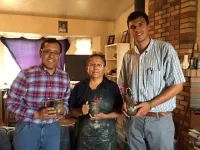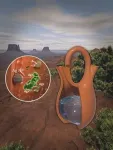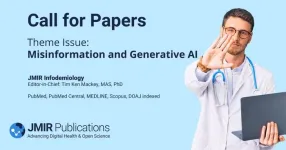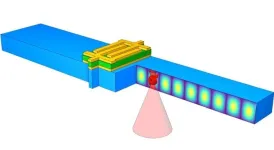(Press-News.org) Large chunks of the Navajo Nation in the Southwest lack access to clean drinkable water, a trend that has been rising in many parts of the U.S. in recent years. A research team led by engineers with The University of Texas at Austin aims to change that.
The team has developed a new water filtration solution for members of the Navajo Nation, lining clay pots with pine tree resin collected from the Navajo Nation and incorporating tiny, silver-based particles that can be used to purify water to make it drinkable.
“Making water filtration technology cheap doesn’t solve all the problems, and making it effective doesn’t solve everything either,” said Navid Saleh, a professor in the Fariborz Maseeh Department of Civil, Architectural and Environmental Engineering and one of the leaders on the project. “You have to think about the people you are making it for.”
And that’s what the researchers did. They worked closely with a third-generation potter from Arizona — Deanna Tso, who is also a co-author on the paper — to create a device that is simple for the users. All they have to do is pour water through the clay pots, and the coated pottery removes bacteria from water and generates clean, drinkable water.
The Navajo Nation has a history of mistrust of outsiders, the researchers say, and that makes it less likely that people there would adopt a new technology made entirely by others. Using pottery, working with the community, and relying on local materials were important to the effectiveness of this project.
The research appears in a new paper in the journal Environmental Science & Technology.
“Navajo pottery is at the heart of this innovation because we hoped it would bridge a trust gap,” said Lewis Stetson Rowles III, now a faculty member at Georgia Southern University’s Department of Civil Engineering and Construction after earning a Ph.D. from UT in 2021. “Pottery is sacred there, and using their materials and their techniques could help them get more comfortable with embracing new solutions.”
Using silver particles for water filtration is not the main innovation. Others have used this technology in the past. The key is controlling the release of nanoparticles, which can reduce the usable life of the filters. And the silver particles mix at high volume with some of the chemicals, such as chloride and sulfide, in the untreated water, leading to a “poison layer” that can reduce the disinfection efficacy of the silver particles on the clay lining.
The researchers used materials abundant in the environment of the community, including pine tree resin, to mitigate the uncontrolled release of silver particles during the water purifying process. The materials and construction process for the pots cost less than $10, making for a potentially low-cost solution.
“This is just the beginning of trying to solve a local problem for a specific group of people,” Saleh said. “But the technical breakthrough we’ve made can be used all over the world to help other communities.”
This research dates back to close to 10 years. The original idea for this project was sketched out on a Subway napkin and refined over many trips to those communities, experiments, and iterations. Rowles himself has pottery skills, and a desire to work on this issue of a lack of drinking water in native communities.
The next step for the researchers is to grow the technology and find other materials and techniques to help communities use the materials abundant in their regions to help create fresh, drinkable water. The researchers are not seeking to commercialize the research, but they are eager to share it with potential partners.
Other team members on the project include Desmond Lawler, a professor emeritus, who was Rowles’ co-adviser; civil, architectural and environmental engineering professor Mary Jo Kirisits; and Andrei Dolocan, a senior research scientist at the Texas Materials Institute.
END
Pottery becomes water treatment device for Navajo Nation
2023-10-26
ELSE PRESS RELEASES FROM THIS DATE:
AWE launching to space station to study atmospheric waves via airglow
2023-10-26
NASA’s Atmospheric Waves Experiment, or AWE, mission is scheduled to launch to the International Space Station in November 2023, where it will make use of a natural, ethereal glow in Earth's sky to study waves in our planet's atmosphere.
Built by Utah State University’s Space Dynamics Laboratory in North Logan, Utah, AWE will be mounted on the exterior of the space station. From this perch, AWE will stare down toward Earth, tracking undulations in the air known as atmospheric gravity waves (AGWs).
Primarily ...
Research advances toward goal of net zero carbon emissions
2023-10-26
Scientists may be on the verge of taking a big step closer to the net-zero carbon emissions goal, thanks to University of Houston research into algae. Hidden potential is being revealed in the major algae studies at the microbial products lab, located at UH at Sugar Land.
The research project is detailed in a newly published article in Green Chemistry, a journal of the Royal Society of Chemistry.
Venkatesh Balan, associate professor of engineering technology in UH’s Cullen College of Engineering’s Division of Technology, is ...
JMIR Infodemiology call for papers theme issue on misinformation and generative AI
2023-10-25
JMIR Infodemiology Editor-in-Chief: Tim Ken Mackey, MAS, PhD welcomes submissions to a special theme issue “Exploring the Intersection Between Health Information, Disinformation, and Generative AI Technologies.”
JMIR Infodemiology, currently indexed in PubMed Central, PubMed, Scopus, DOAJ, and CABI, is a peer-reviewed premier journal in the field of infodemiology, health information, data science, and misinformation and is inviting submissions from different disciplines of health communication, public health, informatics, data science, social ...
Yale School of Nursing receives historic gift for scholarships
2023-10-25
Yale School of Nursing (YSN) has received a landmark gift — the largest single donation in the school’s history. The $11.1 million gift from a generous anonymous donor was announced on Sept. 21 by Azita Emami, dean of the Yale School of Nursing, at an event kicking off the school’s yearlong centennial celebration (September 2023–May 2024).
This endowed gift will support the YSN Community Scholars program, providing full-tuition scholarships to six students each year in the Master of Science in Nursing ...
Birmingham rare earth magnet recycling technology selected as a Minerals Security Partnership project
2023-10-25
A Principals’ meeting of the Minerals Security Partnership (MSP) has confirmed that HyProMag Ltd, which uses a technology developed by the University of Birmingham’s Magnetic Materials Group has been selected as one of the projects that will help to develop responsible critical mineral supply chains.
Formed in 2022 by 14 governments, the Mineral Security Partnership (MSP) aims to ensure adequate supplies of minerals such as rare earths to meet net zero-carbon goals. It aims to support public and private sector investments building diverse, secure, and responsible global critical minerals supply chains.
HyProMag was one ...
Novel small molecule 5D4 disrupts several molecular pathways, including MYC, that lead to cancer growth
2023-10-25
Researchers at Baylor College of Medicine have identified a small molecule named 5D4 that can suppress the growth of breast and ovarian cancers in animal models. 5D4 works by binding to TopBP1 protein in cancer cells, disrupting its interactions with several pathways that promote cancer growth. Combining 5D4 with another cancer inhibitor, talazoparib, enhances the effectiveness of the anti-cancer activity. The study, published in the Proceedings of the National Academy of Sciences, strongly supports continuing the investigation toward further developing this strategy for clinical use.
“Cancer development involves many steps of genetic alterations and signaling ...
Unlocking pathways to break down problem proteins presents new treatment opportunities
2023-10-25
When targeting problem proteins involved in causing or spreading disease, a drug will often clog up a protein’s active site so it can’t function and wreak havoc. New strategies for dealing with these proteins can send these proteins to different types of cellular protein degradation machinery such as a cell’s lysosomes, which act like a protein wood chipper.
In a new study published in Science on Oct. 20, Stanford chemists have uncovered how one of the pathways leading to this protein “wood chipper” works. In doing so, they have opened the ...
Using sound to test devices, control qubits
2023-10-25
Acoustic resonators are everywhere. In fact, there is a good chance you’re holding one in your hand right now. Most smart phones today use bulk acoustic resonators as radio frequency filters to filter out noise that could degrade a signal. These filters are also used in most Wi-Fi and GPS systems.
Acoustic resonators are more stable than their electrical counterparts, but they can degrade over time. There is currently no easy way to actively monitor and analyze the degradation of the material quality of these widely used devices.
Now, researchers at the Harvard John ...
Oregon State researchers uncover mechanism for treating dangerous liver condition
2023-10-25
CORVALLIS, Ore. – A study spearheaded by Oregon State University has shown why certain polyunsaturated fatty acids work to combat a dangerous liver condition, opening a new avenue of drug research for a disease that currently has no FDA-approved medications.
Scientists led by Oregon State’s Natalia Shulzhenko, Andrey Morgun and Donald Jump used a technique known as multi-omic network analysis to identify the mechanism through which dietary omega 3 supplements alleviated nonalcoholic steatohepatitis, usually abbreviated to NASH.
The mechanism involves ...
More than just carbs: starchy vegetables play an integral role in meeting nutrition needs
2023-10-25
A perspective recently published in Frontiers in Nutrition underscores the unique role starchy vegetables play as a vital vehicle for essential nutrients. The Dietary Guidelines for Americans currently recommend that most adults consume five to six cups (or cup equivalents) of starchy vegetables each week to help meet their total vegetable goals.1 Yet, as confusion around “good versus bad carbs” persists among consumers, there is a risk of starchy vegetable avoidance in favor of other carbohydrate foods perceived as ...




